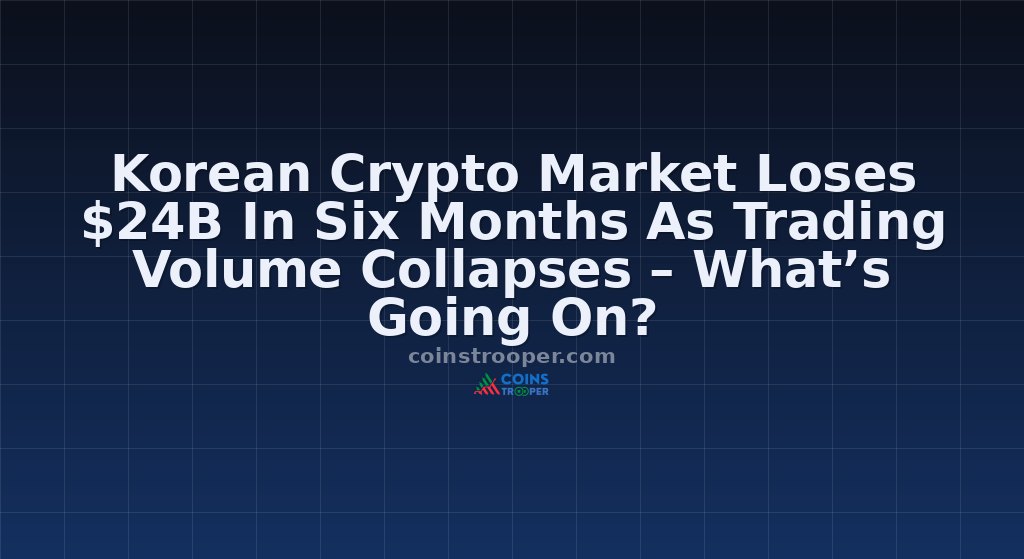Korean Crypto Market Loses $24B In Six Months As Trading Volume Collapses – What’s Going On?

- Exchange deposits fell from KRW 10.7 trillion to KRW 6.2 trillion, confirming widespread fund outflows.
- Korean retail investors shifted focus from crypto to domestic equities, which outperformed overseas markets amid a strengthening won currency.
- tech stocks, with monthly purchases dropping from $1.68 billion between January and April to just $260 million by July.
- The Democratic Party also launched a crypto policy task force this month, promising legislation before the end of the year to foster industry growth.
What Happened
The decline occurred despite Bitcoin’s price appreciation during the same period, indicating retail investors were actively withdrawing from crypto markets rather than experiencing passive losses.
Korean retail investors shifted focus from crypto to domestic equities, which outperformed overseas markets amid a strengthening won currency.
The Democratic Party also launched a crypto policy task force this month, promising legislation before the end of the year to foster industry growth.
The Bank of Korea attributed the decline in the crypto market partly to Korean investors’ strategic pivot toward domestic equities during a period of relative outperformance.
Local stock markets provided attractive alternatives as global uncertainty around U.S. tariff policies created volatility in overseas investments.
Korean retail investors demonstrated particular disillusionment with Tesla, selling a net $657 million in August alone as the electric vehicle maker lost its compelling narrative.
Korean crypto investors maintained significant positions despite the outflows, with over 10,000 residents holding assets exceeding 1 billion won ($750,000).
In fact, survey data revealed that 51% of South Koreans aged 20-59 have experience with crypto trading, with 27% currently holding digital assets, averaging 13 million won ($9,547) per investor.
President Lee Jae-myung’s administration has launched comprehensive crypto-friendly reforms, reclassifying trading firms as “venture companies” to grant them access to tax incentives and state-backed financing that was previously denied since 2018.
Market Context
South Korean crypto market has shed approximately $24 billion in six months, with domestic crypto holdings plummeting from KRW 121.8 trillion to KRW 89.2 trillion between January and June 2025, according to the Bank of Korea’s latest Financial Stability Report.
The massive outflow coincided with a dramatic collapse in trading activity, as daily volumes crashed from KRW 17.1 trillion in December 2024 to just KRW 3.2 trillion by June.
Active Withdrawal Despite Bitcoin Price Gains
Daily trading volumes on domestic crypto exchanges experienced an unprecedented decline of over 80% from their peak levels.
The decline affected stablecoin trading growth, which had been expanding steadily before slowing during the withdrawal period.
Despite the domestic downturn, global crypto markets reached a total capitalization of $4.2 trillion by September, representing 3.2% of the worldwide stock market value.
Institutional adoption and legislative progress, including the passage of the U.S. GENIUS Act, supported the growth of the international crypto market.
The nation’s 10.86 million active trading accounts represent roughly 20% of the total population.
Government Pushes Pro-Crypto Agenda Despite Market Decline
Why It Matters
Exchange deposits fell from KRW 10.7 trillion to KRW 6.2 trillion, confirming widespread fund outflows.
The pivot was particularly pronounced in U.S. tech stocks, with monthly purchases dropping from $1.68 billion between January and April to just $260 million by July.
Details
However, South Korean authorities are simultaneously accelerating pro-crypto policies, with President Lee Jae-myung designating digital asset ecosystem development as a “key national task.”
Mass Exodus From Crypto to Traditional Assets
Instead, crypto-related stocks, such as Bitmine Immersion Technologies, attracted $253 million in net inflows.
Early adopters typically began with Bitcoin before diversifying into altcoins and stablecoins, with 60% starting during the 2020 bull run.

